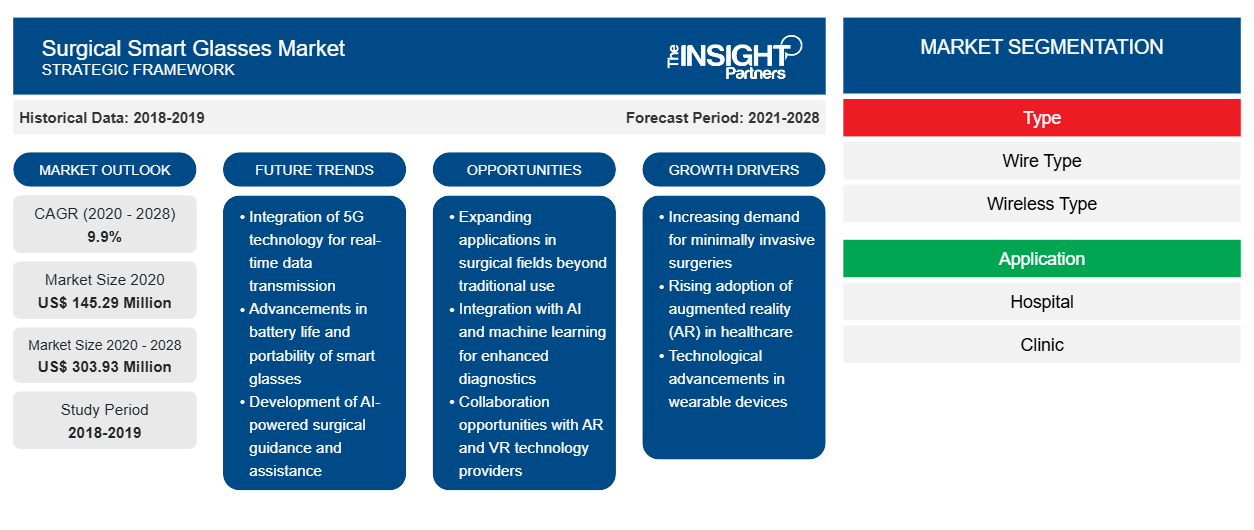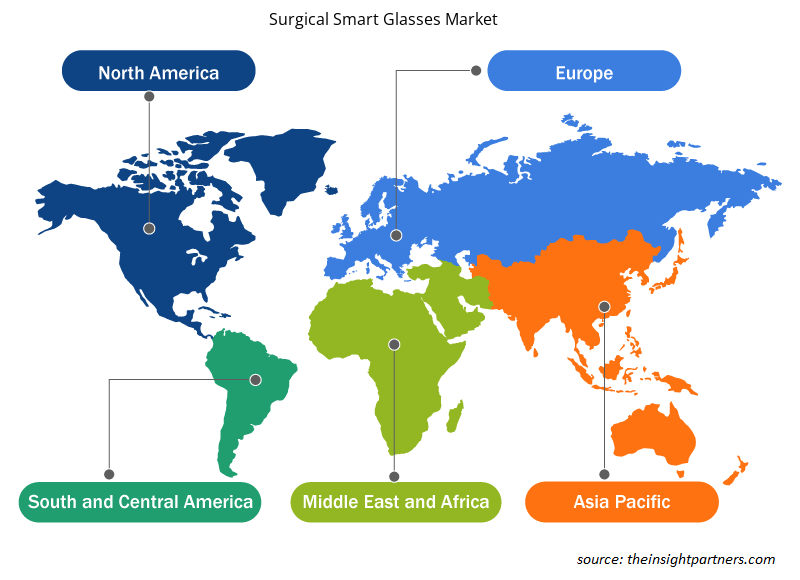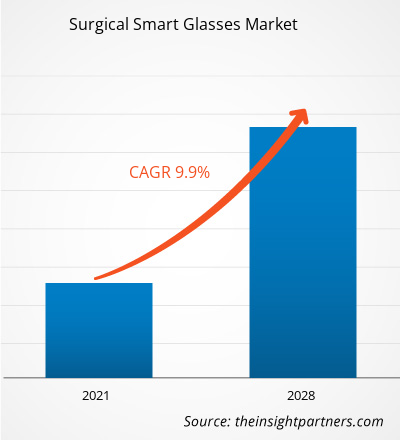The surgical smart glasses market was valued at US$ 145,287.76 thousand in 2020 and is projected to reach US$ 303,934.14 thousand by 2028; it is expected to grow at a CAGR of 9.9% from 2021 to 2028.
Surgical smart glasses provide a smarter way to perform surgeries across the globe. Surgeons wear these glasses while performing a surgery and expert professionals from outside can view the surgery through these smart glasses and give advice regarding the surgery. Surgeon in Operation Theater can communicate with another surgeon with the help of microphones of the glasses and share the surgical view with the wide lens camera on the surgical smart glass.
The surgical smart glasses market is segmented on the basis of type, end user, and geography. By geography, the market is segmented into North America, Europe, Asia Pacific, the Middle East & Africa, and South and Central America. The report offers insights and in-depth analysis of the surgical smart glasses market, emphasizing on parameters such as market trends, technological advancements, and market dynamics along with the analysis of competitive landscape of world’s leading market players.
Customize This Report To Suit Your Requirement
You will get customization on any report - free of charge - including parts of this report, or country-level analysis, Excel Data pack, as well as avail great offers and discounts for start-ups & universities
Surgical Smart Glasses Market: Strategic Insights

- Get Top Key Market Trends of this report.This FREE sample will include data analysis, ranging from market trends to estimates and forecasts.
You will get customization on any report - free of charge - including parts of this report, or country-level analysis, Excel Data pack, as well as avail great offers and discounts for start-ups & universities
Surgical Smart Glasses Market: Strategic Insights

- Get Top Key Market Trends of this report.This FREE sample will include data analysis, ranging from market trends to estimates and forecasts.
Market Insights
Nowadays, healthcare professionals are emphasizing on the utilization of digital instruments and systems to raise the quality of patient treatment and experience. The healthcare systems across the world are witnessing the adoption of smart glasses and wearable computing devices during surgical procedures with an aim to offer superior surgical outcomes. Smart glasses are web-connected wearable computing devices, used to transmit multiple types of data and project it on monitors. In general, a hands-free system is majorly preferred by surgeons as their hands are busy. The smart glasses offer functionalities of standard computers such as voice commands, eye movements, gestures, and simple tactile commands. Further, the glasses can also be used for recording, streaming video, teleconferences, data transmission, and tele mentoring, among others. Moreover, the glasses enable synchronous visualization of bones and tissues on the screen during a surgical procedure. Such images allow surgeons to take accurate and rapid surgical decisions. In addition, the smart glasses help to increase the surgical precision, as well as reduce overall surgical procedural duration by 30%.
The increasing emphasis on achieving improved treatment outcomes is actively contributing to the growth of the surgical smart glasses market. There is high possibility of the occurrence of adverse effects of many surgical procedures, which might as well lead to mortality. Therefore, in crucial cases, it becomes very essential to utilize advanced equipment to avoid possible ill-effects. According to a study published by the World Health Organization (WHO) in 2019, unsafe medical care causes ~2.6 million deaths each year in the low- and middle-income countries. Such significant extent of lethality is anticipated to boost the adoption of advanced computing devices, which will eventually bolster the growth of surgical smart glasses market during the forecast period.
Increasing Number of Surgical Procedures Contribute Significantly to Market Growth
The rising prevalence of chronic diseases such as cancer, diabetes, cardiovascular diseases (CVDs), stroke, and kidney diseases is expected to have a positive impact on the number of surgical procedures across the globe. As per the WHO, CVDs are the leading cause of mortality, and they result in the deaths of ~17.9 million people every year across the world. Moreover, as per the International Diabetes Federation’s Diabetes Atlas Ninth edition 2019, about 463 million adults (aged 20–79 years) had diabetes in 2019, and the number is expected to reach 700 million by 2045. Such high prevalence of chronic conditions is expected to drive the number of surgical procedures, which will ultimately boost the growth of the surgical smart glasses market. For instance, according to the data published by the Obesity and Metabolic Surgery Society of India in 2020, the number of bariatric surgeries in India increased by around 86.7% during 2014–2018 in India. In addition, according to the study published by the American Society for Metabolic and Bariatric Surgery, in 2019, around 252,000 weight loss surgeries were performed in the US.
Type Insights
Based on type, the global surgical smart glasses market is bifurcated into wireless type and wire type. In 2020, the wireless type segment held a larger share in the market. Moreover, the market for the same segment is expected to hold a higher market share by 2028. The wireless surgical smart glasses allow real-time streaming video of surgery to multiple locations, by reducing travel time and enabling access of healthcare to remote locations. This factor, in turn, is likely to boost the demand for surgical smart glasses across the world in the forecast period.
End User Insights
Based on end user, the global surgical smart glasses market is segmented into hospital, clinic, and others. The hospital segment held the largest market share in 2020, and it is further expected to dominate the market by 2028. Hospitals are primary contact points for patients to get their diagnosis done and opt for treatment options and alternatives.
Product launches, and mergers and acquisitions are highly adopted strategies in the global surgical smart glasses market. A few of the recent key product developments are listed below:
- In Jun 2020, MediThinQ commercially launched wireless smart glasses GV-200C. These wireless smart glasses solutions provide surgical site vision to front of eyes regardless of surgeon's position and orientation. Surgeon is able to have identical image on smart glasses instead of monitor for convenience and higher efficiency.
- In May 2020, Taiwan Main Orthopaedic Biotechnology Co., Ltd. received CE, FDA, and ISO 13485 standard approval for its most advanced Augmented Reality Smart Surgical Glasses Foresee-X. With the CE approval, the company has expanded its business in Europe.
The COVID-19 pandemic is having the significant positive impact on the surgical smart glasses market. COVID-19 vaccine has been developed by several pharmaceutical companies and is vaccination has been started. Thus, the surgical smart glasses market is growing due to the increasing awareness about remote clinical support as an option for surgeons, which is also anticipated to have a positive impact on the other segments of the market in the coming months. On the other side, disruptions in the supply chain caused due to the halt in global operations are hindering the market growth.
Surgical Smart Glasses Market Regional Insights
The regional trends and factors influencing the Surgical Smart Glasses Market throughout the forecast period have been thoroughly explained by the analysts at Insight Partners. This section also discusses Surgical Smart Glasses Market segments and geography across North America, Europe, Asia Pacific, Middle East and Africa, and South and Central America.

- Get the Regional Specific Data for Surgical Smart Glasses Market
Surgical Smart Glasses Market Report Scope
| Report Attribute | Details |
|---|---|
| Market size in 2020 | US$ 145.29 Million |
| Market Size by 2028 | US$ 303.93 Million |
| Global CAGR (2020 - 2028) | 9.9% |
| Historical Data | 2018-2019 |
| Forecast period | 2021-2028 |
| Segments Covered |
By Type
|
| Regions and Countries Covered | North America
|
| Market leaders and key company profiles |
Surgical Smart Glasses Market Players Density: Understanding Its Impact on Business Dynamics
The Surgical Smart Glasses Market is growing rapidly, driven by increasing end-user demand due to factors such as evolving consumer preferences, technological advancements, and greater awareness of the product's benefits. As demand rises, businesses are expanding their offerings, innovating to meet consumer needs, and capitalizing on emerging trends, which further fuels market growth.
Market players density refers to the distribution of firms or companies operating within a particular market or industry. It indicates how many competitors (market players) are present in a given market space relative to its size or total market value.
Major Companies operating in the Surgical Smart Glasses Market are:
- MEDITHINQ CO., LTD
- Taiwan Main Orthopaedic Biotechnology
- IRISTICK
- DTU Srl.
- Vuzix Corporation
Disclaimer: The companies listed above are not ranked in any particular order.

- Get the Surgical Smart Glasses Market top key players overview
Surgical Smart Glasses – Market Segmentation
By Type
- Wireless Type
- Wire Type
By End User
- Hospital
- Clinics
- Others
By Geography
North America
- US
- Canada
- Mexico
Europe
- France
- Germany
- UK
- Italy
- Spain
- Rest of Europe
Asia Pacific (APAC)
- China
- Japan
- India
- Australia
- South Korea
- Rest of Asia Pacific
Middle East & Africa (MEA)
- Saudi Arabia
- South Africa
- UAE
- Rest of Middle East & Africa
South and Central America (SCAM)
- Brazil
- Argentina
- Rest of South and Central America
Company Profiles
- MEDITHINQ CO., LTD
- Taiwan Main Orthopaedic Biotechnology
- IRISTICK
- DTU Srl.
- Vuzix Corporation
- Pixee Medical
- RODS AND CONES.
- AMA XpertEye
- ImmersiveTouch, Inc.
- Microsoft Corporation
Frequently Asked Questions
What are surgical smart glasses?
Surgical smart glasses have provided a smarter way to perform surgeries across the globe. Surgeons who performs a surgery wear these glasses and expert professionals from outside can view the surgery through these smart glasses and also give advice while performing surgeries. Surgeon in Operation Theater can communicate with another surgeon with the help of microphones of the glasses and share the surgical view with the wide lens camera on the surgical smart glass.
Who are the major players in the surgical smart glasses market?
The surgical smart glasses market majorly consists of the players such MEDITHINQ CO., LTD, Taiwan Main Orthopaedic Biotechnology, IRISTICK, DTU Srl., Vuzix Corporation, Pixee Medical, RODS AND CONES., AMA XpertEye, ImmersiveTouch, Inc., and Microsoft Corporation are among others.
What are the driving factors for the surgical smart glasses market across the globe?
The factors that are driving growth of the market are growing emphasis on superior surgical procedural outcomes and increasing number of surgical procedures are anticipated to drive the growth of the global surgical smart glasses market during the forecast period. However, lack of awareness and infrastructure challenges to adopt surgical smart glasses in emerging nations are hindering the market growth.
- Historical Analysis (2 Years), Base Year, Forecast (7 Years) with CAGR
- PEST and SWOT Analysis
- Market Size Value / Volume - Global, Regional, Country
- Industry and Competitive Landscape
- Excel Dataset
Testimonials
I wish to appreciate your support and the professionalism you displayed in the course of attending to my request for information regarding to infectious disease IVD market in Nigeria. I appreciate your patience, your guidance, and the fact that you were willing to offer a discount, which eventually made it possible for us to close a deal. I look forward to engaging The Insight Partners in the future, all thanks to the impression you have created in me as a result of this first encounter.
DR CHIJIOKE ONYIA, MANAGING DIRECTOR, PineCrest Healthcare Ltd.The Insight Partners delivered insightful, well-structured market research with strong domain expertise. Their team was professional and responsive throughout. The user-friendly website made accessing industry reports seamless. We highly recommend them for reliable, high-quality research services
Yukihiko Adachi CEO, Deep Blue, LLC.Reason to Buy
- Informed Decision-Making
- Understanding Market Dynamics
- Competitive Analysis
- Customer Insights
- Market Forecasts
- Risk Mitigation
- Strategic Planning
- Investment Justification
- Identifying Emerging Markets
- Enhancing Marketing Strategies
- Boosting Operational Efficiency
- Tracking Industry Innovations
- Aligning with Regulatory Trends
Yes! We provide a free sample of the report, which includes Report Scope (Table of Contents), report structure, and selected insights to help you assess the value of the full report. Please click on the "Download Sample" button or contact us to receive your copy.
Absolutely — analyst assistance is part of the package. You can connect with our analyst post-purchase to clarify report insights, methodology or discuss how the findings apply to your business needs.
Once your order is successfully placed, you will receive a confirmation email along with your invoice.
• For published reports: You’ll receive access to the report within 4–6 working hours via a secured email sent to your email.
• For upcoming reports: Your order will be recorded as a pre-booking. Our team will share the estimated release date and keep you informed of any updates. As soon as the report is published, it will be delivered to your registered email.
We offer customization options to align the report with your specific objectives. Whether you need deeper insights into a particular region, industry segment, competitor analysis, or data cut, our research team can tailor the report accordingly. Please share your requirements with us, and we’ll be happy to provide a customized proposal or scope.
The report is available in either PDF format or as an Excel dataset, depending on the license you choose.
The PDF version provides the full analysis and visuals in a ready-to-read format. The Excel dataset includes all underlying data tables for easy manipulation and further analysis.
Please review the license options at checkout or contact us to confirm which formats are included with your purchase.
Our payment process is fully secure and PCI-DSS compliant.
We use trusted and encrypted payment gateways to ensure that all transactions are protected with industry-standard SSL encryption. Your payment details are never stored on our servers and are handled securely by certified third-party processors.
You can make your purchase with confidence, knowing your personal and financial information is safe with us.
Yes, we do offer special pricing for bulk purchases.
If you're interested in purchasing multiple reports, we’re happy to provide a customized bundle offer or volume-based discount tailored to your needs. Please contact our sales team with the list of reports you’re considering, and we’ll share a personalized quote.
Yes, absolutely.
Our team is available to help you make an informed decision. Whether you have questions about the report’s scope, methodology, customization options, or which license suits you best, we’re here to assist. Please reach out to us at sales@theinsightpartners.com, and one of our representatives will get in touch promptly.
Yes, a billing invoice will be automatically generated and sent to your registered email upon successful completion of your purchase.
If you need the invoice in a specific format or require additional details (such as company name, GST, or VAT information), feel free to contact us, and we’ll be happy to assist.
Yes, certainly.
If you encounter any difficulties accessing or receiving your report, our support team is ready to assist you. Simply reach out to us via email or live chat with your order information, and we’ll ensure the issue is resolved quickly so you can access your report without interruption.















The List of Companies - Surgical Smart Glasses Market
- MEDITHINQ CO., LTD
- Taiwan Main Orthopaedic Biotechnology
- IRISTICK
- DTU Srl.
- Vuzix Corporation
- Pixee Medical
- RODS AND CONES.
- AMA XpertEye
- ImmersiveTouch, Inc.
- Microsoft Corporation






 Get Free Sample For
Get Free Sample For